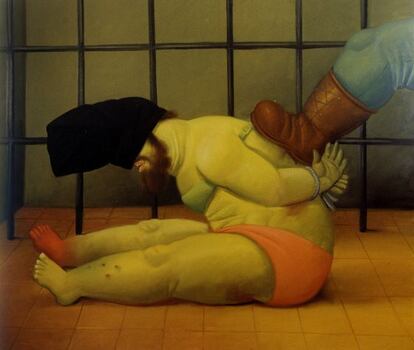Turning up the volume
Bilbao welcomes Fernando Botero's rotund worldview

"I don't paint fat women," says Fernando Botero. "I try to express volume as part of the sensuality of art."
Throughout his career, the Colombian artist has used strong colors and curved lines to compose scenes of chubby characters appearing everywhere from popular dances to bullfights. It is the result, he says, of searching for his own style in his work.
The painter and sculptor has spent 2012 celebrating his 80th birthday, showing his unmistakeable work at different exhibitions around the world. Now, the retrospective Fernando Botero. Celebración, an 80-painting selection from a bigger show presented in Mexico back in March, arrives at Bilbao's Fine Arts Museum, complemented by one of his enormous bronze sculptures, a figure of a horse, installed on the city's Gran Vía boulevard.
Botero's fat women - and fat men - appear in the nude, in circus scenes, in portraits of priests and in his reinterpretations of some of the great works of art history. The fruits that make up his still lifes are as rounded as the hooded men he painted in the series dedicated to Iraqi prisoners tortured at Abu Ghraib. He treats his figures "as if they were almost food," he explains. And no detail escapes his zeal for rounded shapes. "There is coherence in all the painting's figures in a stylistic desire to give prominence to volume."
Behind him is a professional career that began in 1948 as an illustrator on the newspaper El Colombiano in Medellín. He presented his first solo show in Bogota three years later and soon after moved to Madrid to study at the San Fernando Fine Arts Academy. After time living in various European cities and New York, in 1973 he took up residence in Paris, where he started producing sculptures of his rotund figures.
The show, curated by his daughter Lina, begins by reflecting on the influences on his early work from the Italian Renaissance to Mexican muralism and the Colombian tradition. Works inspired by Latin America and scenes of bourgeois life give way to series dedicated to the clergy, the circus and the Abu Ghraib paintings.
Botero remains active today and his latest series is dedicated to the Stations of the Cross. "Twenty-first-century art has tried to replace painting with other forms of expression," he says. But Botero believes video works are closer to cinema and installations closer to theater. "Painting still has a way to go. Why replace it?"
Fernando Botero. Celebración. Until January 20 at Museo de Bellas Artes de Bilbao, Museo Plaza 2, Bilbao. www.museobilbao.com
Tu suscripción se está usando en otro dispositivo
¿Quieres añadir otro usuario a tu suscripción?
Si continúas leyendo en este dispositivo, no se podrá leer en el otro.
FlechaTu suscripción se está usando en otro dispositivo y solo puedes acceder a EL PAÍS desde un dispositivo a la vez.
Si quieres compartir tu cuenta, cambia tu suscripción a la modalidad Premium, así podrás añadir otro usuario. Cada uno accederá con su propia cuenta de email, lo que os permitirá personalizar vuestra experiencia en EL PAÍS.
¿Tienes una suscripción de empresa? Accede aquí para contratar más cuentas.
En el caso de no saber quién está usando tu cuenta, te recomendamos cambiar tu contraseña aquí.
Si decides continuar compartiendo tu cuenta, este mensaje se mostrará en tu dispositivo y en el de la otra persona que está usando tu cuenta de forma indefinida, afectando a tu experiencia de lectura. Puedes consultar aquí los términos y condiciones de la suscripción digital.
Últimas noticias
Cubans look to Venezuela fearfully after Trump’s incursion: ‘We could be next’
The operation in Venezuela to capture Maduro threatens to widen the cracks in the MAGA movement
Trump clarifies who is ultimately in charge in Venezuela: ‘Me’
Maduro pleads not guilty before the federal court in New York: ‘I am still the president of Venezuela’
Most viewed
- Alain Aspect, Nobel laureate in physics: ‘Einstein was so smart that he would have had to recognize quantum entanglement’
- Gilles Lipovetsky: ‘If you want to live better and fall in love, take Prozac, don’t look to philosophy’
- Alvin Hellerstein, a 92-year-old judge appointed by Bill Clinton, to preside over Maduro’s trial in New York
- Cuba confirms death of 32 of its citizens in the US attack against Venezuela
- Why oil has been at the center of Venezuela-US conflicts for decades








































